
Looking for U.S. Apple Crop Facts in 2025? Scroll down this page and follow the links. And if you bring home some fruit or vegetables and want to can, freeze, make jam, salsa or pickles, see this page for simple, reliable, illustrated canning, freezing or preserving directions. There are plenty of other related resources, click on the resources dropdown above. If you are having a hard time finding canning lids, I've used these, and they're a great price & ship in 2 days.
If you have questions or feedback, please let me know! There are affiliate links on this page. Read our disclosure policy to learn more.
U.S. Apple Crop Facts
2025 U.S. Apple Crop Facts
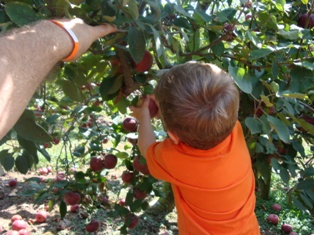 Apples
are one of the easiest fruit to pick and use. They're big, not easily
bruised, most varieties store well, they can be eaten fresh, cooked, canned, frozen and made into many tasty
and healthy dishes. Apples are fat-free, low sodium, and cholesterol-free. A bushel
weighs between 42 and 48 lbs. A medium apple
has about 80 calories. Apples originated in the Middle East (in an area between
the Caspian and the Black Sea) more than 4000 years ago! They were the favorite
fruit of ancient Greeks and Romans. Apples arrived in England at around the time
of the Norman conquest (in 1066) and English settlers brought them to America in
the 1600 and 1700's. Only the crabapple is native to North America. Johnny Appleseed did really exist; his name was John
Chapman, and he was born on September 26,1774 near Leominster, Massachusetts.
(For
more about Johnny Appleseed, see this page!) What are the most popular U.S. fruits? click here.
Apples
are one of the easiest fruit to pick and use. They're big, not easily
bruised, most varieties store well, they can be eaten fresh, cooked, canned, frozen and made into many tasty
and healthy dishes. Apples are fat-free, low sodium, and cholesterol-free. A bushel
weighs between 42 and 48 lbs. A medium apple
has about 80 calories. Apples originated in the Middle East (in an area between
the Caspian and the Black Sea) more than 4000 years ago! They were the favorite
fruit of ancient Greeks and Romans. Apples arrived in England at around the time
of the Norman conquest (in 1066) and English settlers brought them to America in
the 1600 and 1700's. Only the crabapple is native to North America. Johnny Appleseed did really exist; his name was John
Chapman, and he was born on September 26,1774 near Leominster, Massachusetts.
(For
more about Johnny Appleseed, see this page!) What are the most popular U.S. fruits? click here.
Current Season (2025) Apple Crop Data and Facts
How big will this year's crop be? It depends upon who you ask, since (in the major apple growing areas) there were no big, late damaging freezes and rainfall has been consistent, this could be a record. The Washington State Tree Fruit Association released their forecast for the 2025 fresh apple crop, and the 142 million standard 40-pound boxes (bushel boxes) predicted would be a significant increase over last fall's 124 million box harvest. Washington State produces almost half of the entire U.S. apple harvest.
If that holds nationally, we could expect the 2025 total U.S. apple crop to be around 263 million
bushels.
The entire U.S. national apple harvest in 2024 was approximately 260 million bushels, a
10.1% decrease compared to the 2023 final production.
Gala is expected to be the top variety, followed
by Red Delicious, Granny Smith, Honeycrisp, and Fuji; but Cosmic Crisp is moving up, entering the Top 5 in
Washington's 2025 apple forecast.
The first estimate of the size of the current year's United States apple crop will be released in August by the USDA. A few weeks later The U.S. Apple Association's releases their estimate.
1 bushel is 40-42 lbs; for calculations,
National Statistics for Apples
Here are the U.S. national apple crops by year in pounds and bushels.

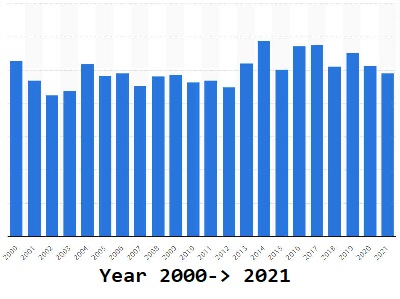 A good year is anything above 245 million bushels. Historically, the trend is steadily upward,
with occasional dips for a late freeze. The five-year
average for 2019-2024 was 251 million bushels, while 2009-2014 was 227.7 million bushels.
A good year is anything above 245 million bushels. Historically, the trend is steadily upward,
with occasional dips for a late freeze. The five-year
average for 2019-2024 was 251 million bushels, while 2009-2014 was 227.7 million bushels.
The top U.S. crop was 282 million bushels in both 2013 and 2014.
The global apple crop of world production for 2019-2020 rose nearly 5.0 million metric tons (tons) to 75.8 million metric tons., so overal we see an erratic (obviously weather plays a role) but steady gradual increase in apple crop production.
Comparison of major apple producing states
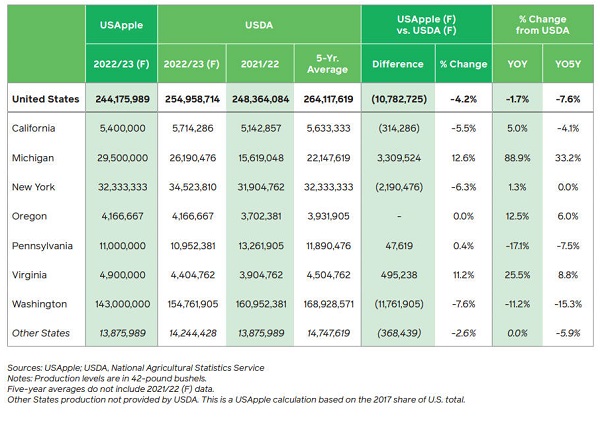 Michigan
and Viginia's apple crops are up substantially in 2022, while California, Washington state and NY state are seeing declines. Oregon appears to be
flat or up slightly. See the chart at right from U.S. Apple.org
Michigan
and Viginia's apple crops are up substantially in 2022, while California, Washington state and NY state are seeing declines. Oregon appears to be
flat or up slightly. See the chart at right from U.S. Apple.org
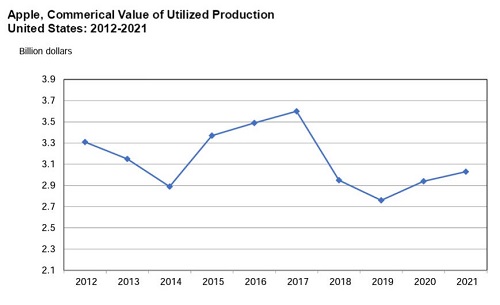
Costs and Values of Apples
According to the USDA, the value of the U.S. apple crop in 2018 was approximately $3.6 billion. See the chart at right.
Apple prices will likely be up each year by an average of 5% to 10%, assuming weather conditions remain normal. It seems like apple prices increase faster than overal inflation and faster than overal food pricing.
Previous Year's Apple Crop Figures
Fruit Grower News reported that the US Apple Association announced that the 2013 U.S. apple crop was about 248.6 million bushels (the August 2013 forecast was for 243 million bushels). That's a 15 percent increase over 2012's final crop of 215 million bushels, and a 11 percent increase over the five-year average (224 million bushels). It's the largest crop since 2004, according to USDA numbers.
The price range for apples wholesale (such as at large real farm markets and at orchards) was between $18 to $40 per bushel, depending upon the variety and location. Popular varieties, like Gala, Fuji, Honeycrisp, etc. were around $25 - $33/bushel (wholesale). The inflation that we are seeiong for gasoline, housing and everything else is definitely affecting apple prices as well.
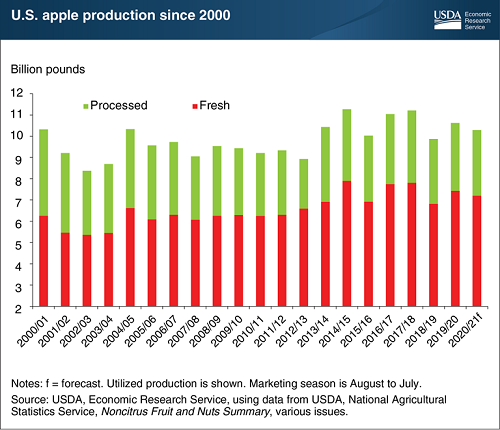 Fresh vs. processed by
year
Fresh vs. processed by
year
The chart at right from the USDA gives a good visual representation of the uses of apples. About 60% of the crop is typically processed into commercial apple juice, applesauce, apple butter, etc.
Who are the top apple producers, by Country and state?
The People's Republic of China now produces the largest amount of apples, 2.5 billion bushels, around half of the world’s total supply. In 2021, Turkey overtook the U.S. to become the world’s second largest apple producer widening the gap between us (with 253 million bushels, 5% of world production). The U.S., in 3rd place, was had 232 million bushels and 4.6% of world production. Rounding out the top five were Poland (4.4%) and India (2.7%).
As of March 2025:
- PRC (China)
- Turkey,
- United States,
- Poland,
- India,
- Italy
- France.
Apples are grown in almost every state of the U.S., but since apples cannot set fruit and produce a viable crop unless they get enough total hours of cold each winter, warm winter states like Florida and warm areas of Texas, etc. do not produce commercial crops. That leaves about 32 states growing apples commercially.
Washington State is by far the largest producing state for apples in the United States. Washington State produces over half of all apples commercially grown in the U.S.. The top ten apple producing states, in order, are:
- Washington (2021 was 154 million bushels (6.76 billion lbs, down from 171 million bushels in 2018)
-
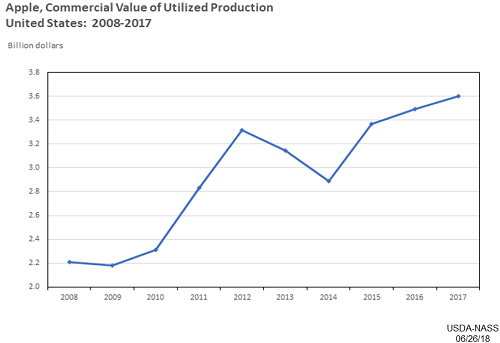 New
York
New
York - Michigan
- Pennsylvania
- California
- Virginia
- North Carolina
- Oregon
- Ohio
- Idaho
Apple seasons
Fresh apples appear in grocery stores all year round now, thanks to a global marketplace, but the northern hemisphere's apple season is typically from as early as July to as late as November. The peak of the apple season is September and October.
So where do apple come from the rest of the year? Some (not all)
varieties of apples store very well, and will keep for months in storage
warehouses that maintain the proper temperature and humidity. That
extends the season until 6 months later (March / April) when apples from the
southern hemisphere are in season. Which means that from March to July
fresh apples in U.S. grocery stores come from the southern hemisphere,
mostly from Chile and New Zealand. That accounts for about 6% of annual U.S.
apple consumption according to the U.S. Apple organization.
Apple Exports and Imports
Apple Exports
Approximately 1/3 of the U.S. apple crop is exported to Mexico, Canada, India, Taiwan, United Arab Emirates, Hong Kong, Vietnam, Indonesia, Saudi Arabia and Thailand (U.S. Apple Association, 2021).
Apple Imports
Of course, during the off-season (February to July) the United States does import fresh apples. Most of these apples are imported from the Southern Hemisphere, (Chile, Argentina, Venezuela, etc.) since the seasons are reversed. The apples you see on grocery store shelves in Winter and Spring months are typically imported, although some are stored in cold storage from the previous U.S. harvest. . Overall, only five percent of the apples consumed in the United States are imported (U.S. Apple Association, 2021).
Favorite varieties and uses for apples
Two-thirds of the U.S. crop is eaten fresh and one-third goes to processed uses (apple juice, applesauce, apple butter, packaged apple slices, etc.) Apple varieties change over time. Red Delicious is still the most grown apple, making up most of the U.S. apple crop, but as consumer tastes shift, apple growers adapt their orchards, but trimming the trees down to a main trunk and several large branches, and then grafting growing tips of the new variety into those remaining branches. This allows growers to quickly (within 2 years) produce the new variety to meet consumer demand.
Gala and red delicious constantly vie for the top spot, which Gala took from Red Delicious in 2020 and iRed Delicious retook in 2024, with almost 46 million bushels produced, accounting for around 18% of the U.S. apple market. Rounding out the top five are red delicious (34 million bushels), fuji (26 million bushels), Honeycrisp (25 million bushels) and granny smith (24 million bushels).
The top five are typically Red Delicious, Gala, Granny Smith, Honeycrisp and Fuji.
Honeycrisp continues to gain. The top ten apple varieties currently grown in the United States are:
- Red Delicious (12.3%)
- Gala
- Fuji
- Honeycrisp
- Granny Smith (10%)
- McIntosh
- Golden Delicious
- Cripps Pink (aka, Pink Lady)
- Rome
- Empire
Pink Lady/cripps pink and Cosmic Crisp continue to gain popularity. Red Delicious production continues to decline.
Growing Fact:
Did you know that the orchardists do not usually cut a tree down to change the cvariety? They just cut it way back and graft the new variety onto the half dozen or so remaining branches. In this manner, the tree will be producing again within a year or two
Canning apples - fully illustrated, with step-by-step instructions
- How to make applesauce
- How to make apple butter
- NEW: How to make apple jelly
- How to make apple pie filling (canned)
- How to can apples
Recipes, illustrated with step by step instructions
- Apple pie recipe and directions and illustrated! I can say, with, ahem, no bias at all, that this is the best apple pie recipe in the world! (Alright, I did have an apple strudel in Vienna once at that place listed in Fodors that was REALLY good, but that wasn't a pie, was it? And since this was the recipe my grandmother used, it must be great!)
- How to make applesauce for a single meal (not canning it) with NO special equipment
- Apple crunch - best of all! Moist, low sugar and using oats!
- Apple crisp - ever-popular, low sugar and using oats!
- Apple, blackberry, cherry, and/or peach cobbler
- Apple-blackberry, crumble - a English favorite (or favourite)
Want to Grow Your Own Apples?
I do and it's easy and fast. Apple trees I planted in my yard two years ago are bearing several dozen fruit each this year! Here's a guide to selecting a variety to grow and how!
Looking for Apple Cider?
And a fun tour? Check out Cider Mills.com! They list the cider mills where you can go for a tour (and tasting! yum!)
Other Apple Facts and Fun!
- 2500 varieties of apples are grown in the United States.
- 7500 varieties of apples are grown throughout the world.
- About 100 different varieties of apples are grown commercially in the United States.
- A bushel of apples typically weighs between 42 and 48 lbs.
- Apples are grown commercially in 36 states.
- Apples are grown in all 50 states.
- Europeans eat about 46 pounds of apples annually.
- United States consumers ate an average of 45.2 pounds of fresh apples and processed apple products. That's a lot of applesauce!
- 61 percent of United States apples are eaten as fresh fruit.
- 39 percent of apples are processed into apple products; 21 percent of this is for juice and cider.
- The top apple producing states are Washington, New York, Michigan, California, Pennsylvania and Virginia, which produced over 83 percent of the nation's 2001-crop apple supply.
- Apples are a great source of the fiber pectin. One apple has five grams of fiber.
- In 2001 there were 8,000 apple growers with orchards covering 430,200 acres. (don't know how many of those are PYO).
- The pilgrims planted the first United States apple trees in the Massachusetts Bay Colony.
- Apple trees take four to five years to produce their first fruit, but you normally buy 2 or 3 year plants at the nursery, so it's only 2 years till they produce!
- Most apples are still picked by hand in the fall.
- Apple varieties range in size from a little larger than a cherry to as large as a grapefruit.
- In Europe, France, Italy and Germany are the leading apple producing countries.
- Apples are a member of the rose family.
- Apples harvested from an average tree can fill 20 bushel boxes that weigh 42 pounds each.
- 25 percent of an apple's volume is air. That is why they float.
- It takes the energy from 50 leaves to produce one apple.
- Apples are the second most valuable fruit grown in the United States. Oranges are first.
- In colonial time apples were called winter banana or melt-in-the-mouth.
- China is the leading producer of apples with over 1.2 billion bushels grown in 2001. The U.S. is number 2 .
- Newton Pippin apples were the first apples exported from America in 1768, some were sent to Benjamin Franklin in London.
- One of George Washington's hobbies was pruning his apple trees.
- America's longest-lived apple tree was reportedly planted in 1647 by Peter Stuyvesant in his Manhattan orchard and was still bearing fruit when a derailed train struck it in 1866.
- A bushel of apples weights about 42 pounds (up to 48 lbs) and will yield 12 to 15 quarts of applesauce.
- It takes about 36 apples to create one gallon of apple cider.
- And the many apple associations listed on this page have more facts and resources
Weights and Approximate Typical Processed Yields of Apples
|
You should get this much... |
|||
|
Commonly made products |
|||
|
(42-48 lbs) |
1 bushel = 12 to 15 qt.
canned applesauce (no sugar added), 14 - 18 with sugar
1 bushel = 10 to 12 qt. juice |
||
|
|
1 quart applesauce | 2 pints | |
| 8 medium apples = 2.25 lbs | 1 nine-inch apple pie or 3 cups of applesauce |
||
| 1 peck = 10 to 14 lbs | |||
Apple Festivals
Here is a list of major apple festivals in the U.S., Britain, Australia and other countries. If you know of any more, please write me! Feedback.
Other References.
Most sources are references are cited within the article above, but
here are a few others
- U.S. Apple Statistics at Cornell University offers annual data on U.S. and State number of farms, acreage, yield, production, prices, crop value, trade, and per capita use of apples. It also includes monthly data on shipments, imports and exports, and world data on production.
- U.S. Apple Growers Association
- USDA Crop Production statistics
Looking for canning equipment and supplies?
Water bath canner with a jar rack
Pressure canners for gas, electric and induction stoves: Presto 23Qt or T-fal 22Qt
Canning scoop (this one is PERFECT)
Ball Blue book (most recent version)
Jars: 8oz canning jars for jams
Find Other types of farms:
Farm markets and roadside stands
Road trips and camping resources
Local Honey, apiaries, beekeepers
Consumer fraud and scams information
Home canning supplies at the best prices on the internet!
Maple Syrup Farms, sugarworks, maple syrup festivals
Environmental information and resources
Farms For Your Event for birthday parties, weddings, receptions, business meetings, retreats, etc.
Festivals - local fruit and vegetable festivals
Get the
most recent version of
the Ball Blue Book
With this Presto 23 quart pressure canner and pressure cooker, you can "can" everything, fruits, vegetables, jams, jellies, salsa, applesauce, pickles, even meats, soups, stews. Model 01781

You can make jams, jellies, can fruit, applesauce, salsa and pickles with water bath canners, like this Granite Ware 12-Piece Canner Kit, Jar Rack, Blancher, Colander and 5 piece Canning Tool Set

